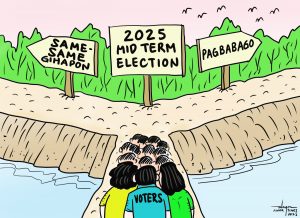OTHER than the seasonal flash floods in Davao City’s downtown area and in some low-lying plains in its outskirts, the most pressing problem that the city is facing is the burgeoning vehicular traffic situation that has been prevailing for quite some time now.
A few columns back we took up the planned, yet palliative, solution City Transport and Traffic Management Office (CTTMO) head Retired P/Col. Dionisio Abude wanted the local government to implement. The recommended solution to ease vehicular traffic is the cutting of the road islands at some strategic sections in order to give drivers better maneuverability when making U-turns as well as dropping or picking passengers where it would not be cumbersome for them to cross the road, especially in national highways, to take another ride or proceed directly to their destination.
While we believe that our idol community relations man would not have laid down to the open his suggestion had he not made a serious study on the matter, we still opine that it could only address the problem on the short term. Of course, the proposal definitely makes sense. But as we said earlier it is one palliative solution to a projected worsening problem in the city.
We wanted to inject some ideas that could help prevent the traffic situation from worsening. In the same column we resurrected a proposal by, if our memory serves us right, former Davao City’s second district councilor Danilo Dayanghirang and some others that one long-term solution was to relocate the Davao City Overland Transport Terminal (DCOTT) from its present location at Ecoland to an area or areas in the outskirts. We also included the plan of the DCOTT transfer proponents to have separate terminals for buses plying the north and south routes if only to reduce the number of public utility buses from the provinces entering the city’s central business district.
On our own, in several instances, we took up in our columns many months ago our own radical idea how to dismantle the one-destination convergence of people in the city’s downtown that also results to all public utility transportations to ply the same routes that are presently the sites of humongous traffic.
Our idea was – and still is – to divide Davao City into three at most, or into two local government units. Of course that would take enough courage by any of our three congressmen to sponsor such a bill considering the already known adverse position of the city administration starting as early during the OIC days of the late Zafiro Respicio and even during the first term of the ruling family.
It really was – and still is – our take that once the city is divided there will be two seats of local governments and its location will depend on what areas will constitute the new LGUs. Say, if the second city will be the whole of District 2, then the new seat of government could be located in Bunawan or Tibungco, whichever is seen to be more strategic for people who will transact with the new city government.
If city number two will cover the areas from Barangay Matina Crossing and the whole of the Third district or just the third district, the new seat of government may be established in Tugbok Proper. Hence all transactions with the new city government will be diverted from the seat of the current city government.
What then is expected to happen? Naturally new routes for passenger vehicles will be established to cater to people who intend to do business with the new city. For example Toril residents will be dealing with LGU offices in Tugbok and not anymore in the current city’s downtown.
Then, if we add the fact that new and bigger educational institutions, malls and large department stores are now setting up branches in these developed areas, it follows that larger new economic enclaves will sprout making travels by people residing in areas under the new city to the present downtown areas already optional on their part.
It definitely is now easy to imagine how big the volume of vehicles will be moved out of the present highways leading and to and going out of the one Davao City.
But as we said in our previous columns and we are saying it again in this article, the sentiment in favor of the city division may be there. However, the courage of any of our congressmen or even any of the city’ civil society groups, to jumpstart such initiative for the city division is very much wanting.


